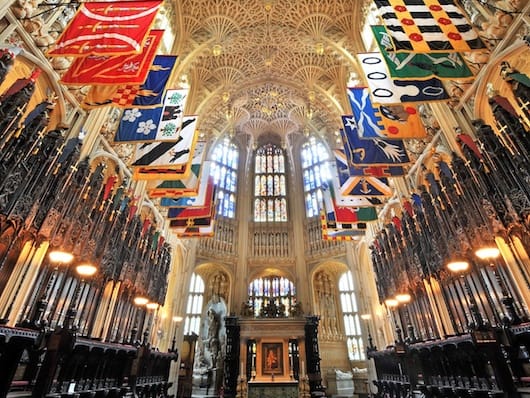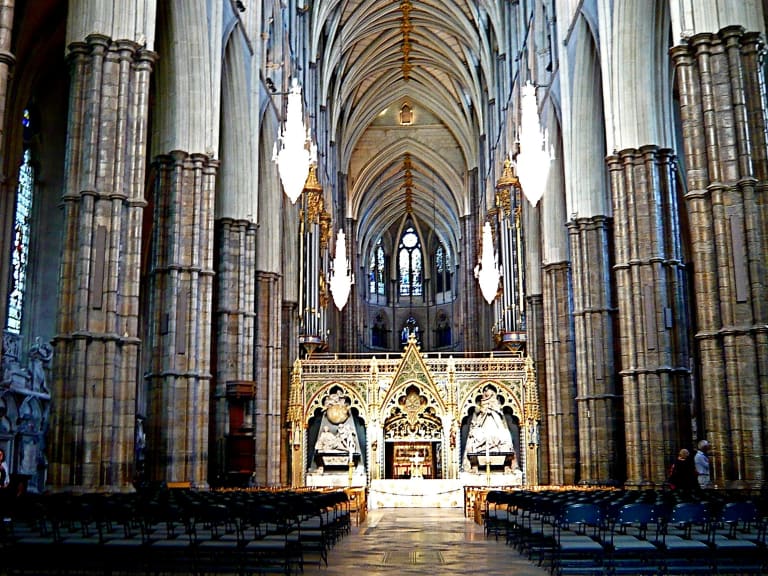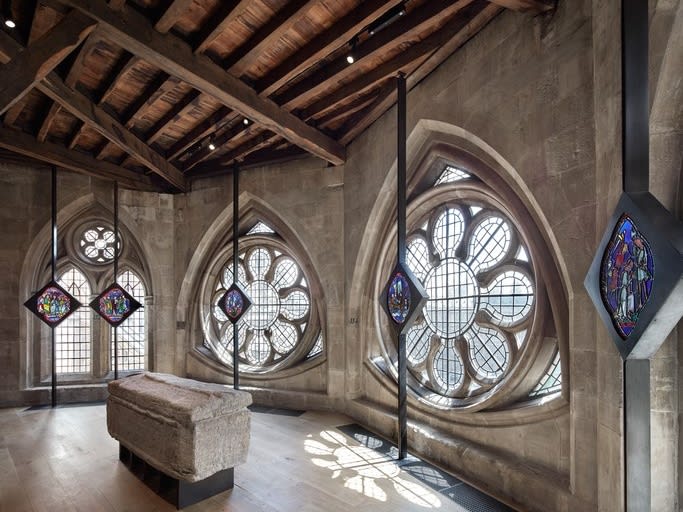More about: 11 Things You Can´t Miss in Westminster Abbey
Westminster Abbey is England's oldest and most important religious building. A national shrine that over the centuries has witnessed numerous royal coronations and houses the tombs of royalty and great British personalities.
A living piece of the country's history and a Gothic artistic gem, it is home to a wealth of precious works of art. In short, one of the essential visits to make in London, whether you are only travelling to London for 2 days or if you are staying in London for a week.
If your plans include visiting this English icon, after buying your tickets to Westminster Abbey and checking the opening hours of the Westminster Abbey, I encourage you to read this post where you will find a small preview of 11 wonderful places to see in Westminster Abbey.
1. The Lady Chapel

At the east end of Westminster Abbey you'll find The Lady Chapel, one of those little artistic treasures of enormous beauty that churches house and that are capable of leaving visitors pleasantly surprised.
Dedicated to the Virgin Mary, its construction began in the 16th century, during the reign of Henry VII of Tudor, and it is of great value as it is considered the last masterpiece of English medieval architecture.
Walking through The Lady Chapel means you can't take your eyes off the fan-vaulted ceiling from which carved gilded pendants hang. A beautiful example of late medieval architecture that fits in perfectly with the rest of the chapel's decoration.
The Lady Chapel is also notable for the colourful heraldic banners above the stalwarts which adorn both sides of the chapel and which correspond to the knights of the Order of the Bath who met here from the 18th century onwards.
The chapel is also tastefully decorated with magnificent stained glass windows, although these are not original as they were destroyed during the Restoration period. They were installed in the 20th century and depict insignia from the fighter squadrons of the Battle of Britain in 1940 and emblems related to the Virgin Mary.
The more than 100 statues of saints around the chapel and symbols such as the English pawn, the rose of the Tudor family, the fleur-de-lis and the Welsh dragon complete this unique space.
2. The Coronation Chair

St George's Chapel is home to one of the most famous pieces of furniture in the world: The Coronation Chair. A medieval chair from the 14th century (the oldest piece of furniture in the country!) on which more than 26 monarchs have been crowned, including the famous Henry VIII, Elizabeth I and the current Queen Elizabeth II of England.
King Edward I had it made to hold the Scone Stone (the rock that the Scots used to crown their kings in the Middle Ages) and which from then on was to be used for the coronations of English sovereigns.
The value of the Scone Stone lies in the fact that, according to the legend held by the kingdoms of Scotland and England, it was the same one that Jacob used to support his head when he dreamt of Jacob's Ladder, an episode recorded in the book of Genesis.
In 1996 the British government returned the stone to Scotland and it can now be seen in Edinburgh Castle but will be given to London each time there is a new coronation.
As for the coronation chair of King Edward I, it remains on display in Westminster Abbey and continues to be used for the purpose for which it was carved.
3. The Royal Tombs

As well as hosting the coronation of numerous kings since the 10th century, Westminster Abbey is also the burial place for many of them.
Strolling through The Lady Chapel you can contemplate the tombs of many monarchs such as Henry VII and Elizabeth of York, Queen Mary I and her sister Elizabeth I, Queen Mary Stuart, Edward V and Richard Duke of York (the Princes in the Tower) and Charles II, among many others.
If you are a fan of historical novels or films, many of these names will surely ring a bell, as their lives have been made into films on many occasions in recent years.
4. Poets' Corner

When you reach the north side of Westminster Abbey you will see one of its most popular spaces, especially for literature lovers who come here on pilgrimage. It is known as Poets' Corner, where more than a hundred literary figures are buried or paid tribute to.
A tradition that began in the 15th century with the burial of the poet Geoffrey Chaucer (author of "The Canterbury Tales") followed by many other renowned writers such as Charles Dickens, Rudyard Kipling, Samuel Johnson and Thomas Hardy.
Other iconic authors of English literature such as William Shakespeare, C.S. Lewis, Jane Austen or the Brontë Sisters have memorials in their honour in Poets' Corner.
5. The Tomb of the Unknown Soldier

Moving now to the west end of Westminster Abbey you will find the Tomb of the Unknown Soldier, where lies an unidentified soldier who took part in World War I (1914-1918) and whose remains were brought from France to England to be buried here, among kings, because as the inscription says: "he did good to God and to his house".
During the Great War, almost a million British soldiers perished in the conflict and many of them could not be identified. This tomb in Westminster Abbey is a tribute to them all. It is undoubtedly one of the most moving places, which you can visit during your visit to the temple.
6. Pyx Chamber

One of the oldest areas of Westminster Abbey is the Pyx Chamber, in the East Cloister of the church.
Entering it is like taking an exciting journey back in time to the church's origins in the 11th century, when King Edward 'the Confessor' wanted to rebuild the previous abbey on the site. From those years, the Pyx Chamber still retains several 11th century tiles and its medieval tiled floor.
In the past, the British crown used this chamber as a treasury and not only valuable pieces of silver and gold but also very important foreign policy documents and treaties were kept in it, as this small room in Westminster Abbey was considered the most secure in the city at the time.
7. The Choir

On your tour of Westminster Abbey you can also see the choir stalls. The original one dates from the Middle Ages and was replaced in the 18th century. The current one is from the 19th century, but the black and white marble floor in this part of the church is original from the 17th century.
This is where the members of the church choir sing, a tradition that dates back to the 10th century and is still celebrated today. In fact, choir services are often held in the church, which anyone can attend.
If you enjoy sacred music, don't hesitate and check out the timetable of events to attend because it's a very special occasion to enjoy the true majesty and spirituality of Westminster Abbey outside of its more touristy side.
8. The Cloisters Cloisters

The Cloisters are one of the most beautiful parts of the Westminster Abbey tour. They convey a great sense of peace and serenity. Walking through the cloister corridors you will feel that, for a moment, time has stood still.
They date from the 13th and 14th centuries and the monks of the Benedictine Order used them for prayer, meditation, exercise or rest and also to move between the different monastic buildings that made up Westminster Abbey, as the Cloisters served as a connection between them.
Curiously, the first twelve monks who came to Westminster were brought to Westminster by St Dunstan (then Bishop of London) in the 9th century and remained here until King Henry VIII dissolved the monastery in the 16th century.
9. The Chapter House

Situated in the East Cloister, this beautiful room served as a meeting place for the monks and the abbot when they wanted to discuss the business of the day, read the 'Rule of St Benedict' or pray, among other things.
The Chapter House was also where the King's Great Council met in the 13th century, which is where English parliamentarianism began in this part of Westminster Abbey. And later, in the 14th century, the House of Commons also met here several times before using the Abbey's Refectory
If you like art, this part of the visit will give you a lot of pleasure looking at the octagonal architecture of the Chapter House, where a pillar rises up towards the vaulted ceiling and fans out. Pay attention also to the mural paintings depicting scenes from the Apocalypse and the stained-glass windows, which are a marvel.
Before you leave, don't forget to check out the wooden door of the Chapter House, which is believed to be the oldest in Britain. Amazing!
10. The Queen's Diamond Jubilee Galleries

During your visit to Westminster Abbey, don't miss The Queen's Diamond Jubilee Galleries, a space within the medieval triforium above the nave of the church that has been hidden from visitors for over 7 centuries.
It is a beautiful museum with stunning views of the interior of the church and the Palace of Westminster, which tells the millennial history of Westminster Abbey from its origins and through hundreds of objects of great historical value.
To enter The Queen's Diamond Jubilee Galleries you need to do so at specific times. In the post Westminster Abbey opening hours you will find more information about it.
11. Collage Garden

The College Garden at Westminster Abbey was the site where the Benedictine monks cultivated their gardens.
It is around a millennium old, making it the oldest park in England. Such a place is well worth a visit, especially when the weather in London is milder and the gardens of College Garden are at their most flowery and beautiful.
The best time to visit this park is in London's spring (between March and May) although summer in London is also a good time. One of my favourite places inside Westminster Abbey!




